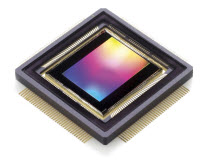
The longest wavelengths are at small X pixel coordinates in the first extension (extension ), the shortest wavelengths are at large X pixel coordinates in the last extension ( in the Hamamatsus, in the e2vDD's, and in the older E2V's). More information and recommended wavelength dither step sizes are provided in the Observing strategies section. The equivalent gap in the wavelength coverage depends on the grating used for the observation. For both Hamamatsu detectors arrays, the effective chip gap width, not usable for science, is wider than the physical chip gap size due to bright edges at either side of the chip gaps. The inter-chip gaps between the new Hamamatsu detectors are 4.88 arcsec wide (61 pixels in unbinned mode) for GMOS-S and 5.41 arcsec wide (67 pixels in unbinned mode) for GMOS-N. The GMOS-S original EEV CCDs, GMOS-N original EEV CCDs, and upgraded GMOS-N e2v DD devices had two ~2.8 arcsec (39 pixel) gaps. Thus, the gaps between the detectors cause small gaps in the wavelength interval covered by a single observation. The dispersion direction of GMOS is along the rows of the image. Long slit spectroscopy can be obtained in either normal or Nod-and-Shuffle modes using GMOS standard slits or custom slits. Some example spectral images and potential strategies to mitigate the effects of scattered light on science data are given here. The GMOS gratings exhibit scattered light, the level of which varies with wavelength and grating. Note that in normal seeing conditions slit losses will be very large for the narrowest slits. The spectral resolving powers available range from about 500 (for the widest slits used on extended objects) to 4400 with a slit width of 0.5 arcsec, and 8800 with the (narrowest) 0.25 arcsec slit. Only the gratings and filters used by all three modes and the detector properties are described in this section. Integral field spectroscopy, which uses 0.2 arcsec fibers covering a 35 square arcsec field of view.Įach of these modes has a separate section in the GMOS pages.Multi-object spectroscopy, which uses custom-designed, laser-milled masks.
Ccd detector chip side length imaging full#
Long-slit spectroscopy, which covers the full extent of the CCD package (3 x 2048 pixels) with two small gaps.

Three types of spectroscopy are possible with each GMOS and its selection of gratings.


 0 kommentar(er)
0 kommentar(er)
